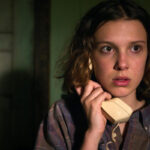For decades, the Kennedy family, a beacon of American political ambition and influence, has been shadowed by an extraordinary series of misfortunes. From devastating plane crashes and shocking assassinations to untimely deaths from illness and tragic accidents, the sheer volume of calamities has led many to question whether a genuine “curse” hangs over this iconic family. As Ted Kennedy himself pondered after a 1969 car crash, having already lost four siblings, “some awful curse did actually hang over all the Kennedys?”
This perception of a “Kennedy curse” is deeply ingrained in popular culture, fueled by the stark contrast between the family’s celebrated achievements and their profound personal losses. Their story, marked by both immense privilege and heartbreaking tragedy, continues to captivate and intrigue people worldwide.
Below, we explore a detailed timeline of the most prominent events that contribute to the narrative of the so-called Kennedy curse.
1941: Rosemary Kennedy’s Lobotomy
Rosemary Kennedy, the eldest daughter of Joseph P. Kennedy Sr. and sister to President John F. Kennedy, faced developmental challenges from a young age, possibly due to oxygen deprivation at birth. As she grew, Rosemary struggled to meet developmental milestones, leading to her enrollment in specialized schools and requiring significant familial support.
By her early twenties, Rosemary’s mental health deteriorated, marked by increasingly volatile mood swings and seizures. Her father, Joseph Kennedy Sr., deeply concerned about the potential impact on the family’s burgeoning political aspirations, made the fateful decision to subject Rosemary to a relatively new and experimental procedure: a prefrontal lobotomy. Crucially, this decision was made without consulting his wife or informing other family members until after the procedure was completed.
Tragically, the lobotomy was performed incorrectly, resulting in devastating consequences for Rosemary. She was left permanently incapacitated, with the intellectual capacity of a toddler, unable to walk or speak coherently. Rosemary spent the remainder of her life in institutional care, effectively removed from public view and rarely discussed openly within the family, reflecting the prevailing societal stigma surrounding mental illness and the Kennedys’ intense focus on their public image.
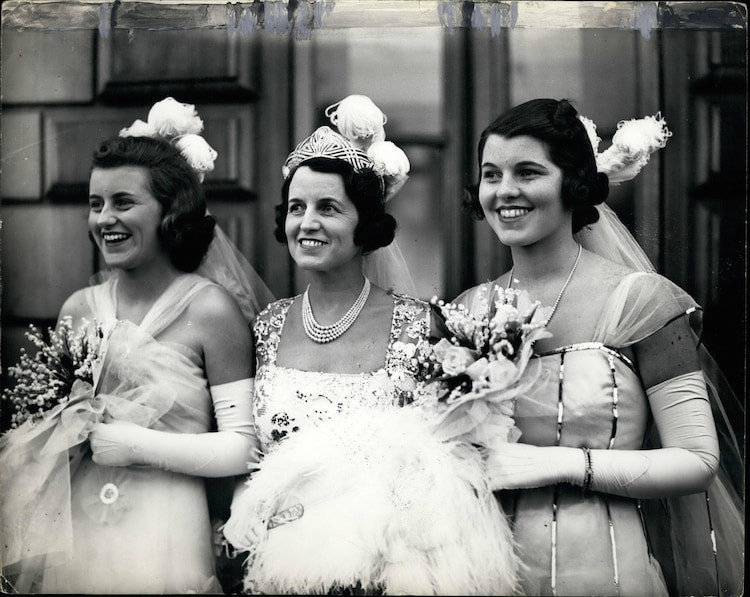 Rosemary Kennedy, Rose Kennedy, and Kathleen Kennedy, 1938
Rosemary Kennedy, Rose Kennedy, and Kathleen Kennedy, 1938
Three Kennedy sisters, Rose Marie “Rosemary” Kennedy, Rose Fitzgerald Kennedy, and Kathleen “Kick” Kennedy, pose for a photo in 1938, a few years before Rosemary underwent a lobotomy.
1944: Joe Kennedy Jr.’s Wartime Death
Joseph P. Kennedy Jr., the eldest Kennedy son, embodied the high ambitions of his father, Joseph Sr., who envisioned him as the first Catholic President of the United States. Joe Jr. had already begun to carve a path in politics when World War II erupted, prompting him to enlist in the U.S. Naval Reserve in June 1941. He trained as a naval aviator and was deployed to Britain, completing 25 combat missions.
Driven by a desire to contribute further, Joe Jr. volunteered for highly dangerous top-secret missions known as Operation Aphrodite and Operation Anvil. On August 12, 1944, while piloting a B-24 Liberator bomber packed with explosives as part of Operation Aphrodite, the bomb detonated prematurely over the English Channel. The explosion obliterated the aircraft, instantly killing Joe Jr. and his co-pilot. He was just 29 years old. The classified nature of his mission meant the full details of his death were not revealed until after the war.
1948: Kathleen ‘Kick’ Kennedy’s Plane Crash
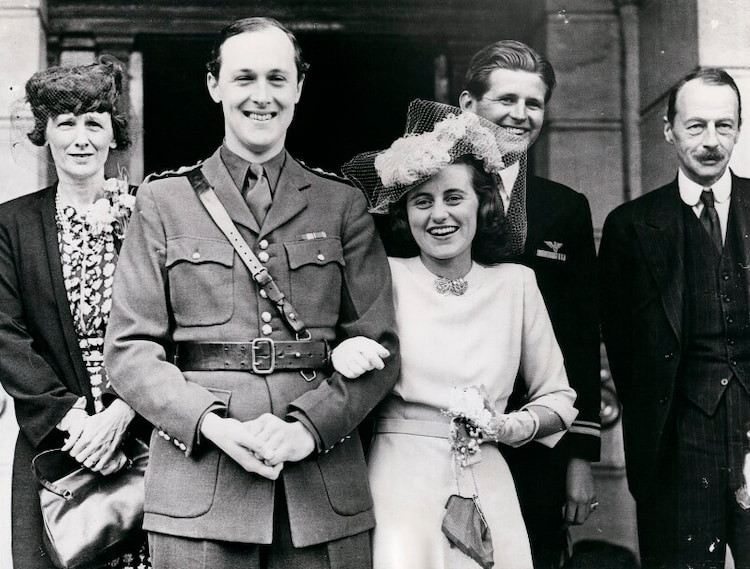 Kathleen Kennedy Wedding, 1944
Kathleen Kennedy Wedding, 1944
Kathleen “Kick” Kennedy and William Cavendish, Marquess of Hartington, pictured at their wedding in 1944, alongside Joseph P. Kennedy Jr. Tragically, both her husband and brother died within the same year.
Kathleen “Kick” Kennedy, known for her independent and spirited personality, decided to visit her father, Joseph P. Kennedy Sr., in Paris to seek his approval of her relationship with Lord Fitzwilliam, a recently divorced British peer. On May 13, 1948, Kick and Lord Fitzwilliam, along with two others, boarded a private plane in Paris bound for the French Riviera.
En route, the aircraft encountered a severe storm and intense turbulence. Emerging from the storm clouds, the plane was caught in a steep, uncontrollable dive, moments from crashing. Despite the pilot’s desperate attempts to regain control, the structural integrity of the plane failed under the extreme stress, and it disintegrated mid-air. All four occupants, including Kick, perished instantly. In a poignant display of disapproval of her relationship, only her father, Joseph P. Kennedy Sr., attended Kick’s funeral, representing the Kennedy family.
1963: The Death of Newborn Patrick Kennedy
In August 1963, President John F. Kennedy and First Lady Jacqueline Kennedy faced another personal tragedy. Jacqueline gave birth prematurely to a son, Patrick Bouvier Kennedy, on August 7th. Immediately baptized, Patrick was quickly diagnosed with hyaline membrane disease, a serious respiratory condition common in premature infants.
Despite intensive medical efforts, Patrick Kennedy succumbed to complications of the disease just 39 hours after his birth. The Kennedys had previously endured a miscarriage and a stillbirth, making Patrick’s brief life and death a particularly devastating loss. However, this tragedy also served to bring the issue of infant respiratory distress syndrome into the national spotlight, spurring increased public awareness and funding for research into its causes and treatment.
1963: Assassination of President John F. Kennedy
On November 22, 1963, the world was shaken by the assassination of President John F. Kennedy in Dallas, Texas. At just 46 years old and nearly three years into his presidency, JFK was fatally shot while riding in a motorcade.
The assassination triggered an unprecedented outpouring of grief and shock across America and globally. For the Kennedy family, it was an unimaginable personal catastrophe, the loss of a husband, father, brother, and son, compounded by the public and political magnitude of the event.
Lee Harvey Oswald, identified as the assassin, was himself murdered just days later before facing trial, fueling widespread and persistent conspiracy theories surrounding JFK’s death. The Warren Commission, established to investigate the assassination, concluded there was no evidence of a conspiracy. However, decades later, public opinion polls consistently show that a majority of Americans believe JFK’s assassination was the result of a conspiracy and that the full truth remains concealed.
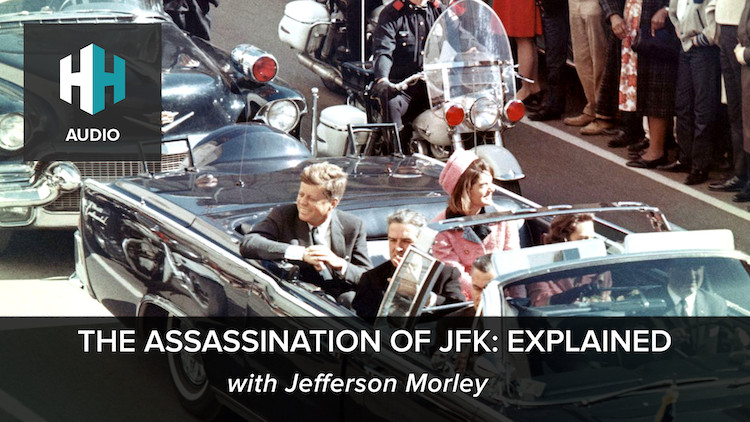 John F. Kennedy
John F. Kennedy
A somber image of John F. Kennedy, the 35th President of the United States, who was assassinated in Dallas, Texas, in 1963.
1968: Assassination of Robert F. Kennedy
Five years after his brother’s assassination, Robert F. Kennedy (RFK), former U.S. Attorney General and then a U.S. Senator for New York, was also assassinated. By 1968, RFK had emerged as a leading contender for the Democratic presidential nomination, following in his brother’s footsteps.
On June 5, 1968, moments after claiming victory in the crucial California primary, RFK was shot in the Ambassador Hotel in Los Angeles by Sirhan Sirhan, a young Palestinian immigrant. Sirhan stated he was motivated by RFK’s pro-Israel stance during the 1967 Six-Day War.
Robert Kennedy’s assassination, another devastating blow to the family and the nation, prompted immediate changes in security protocols. The U.S. Secret Service mandate was expanded to include the protection of major presidential candidates.
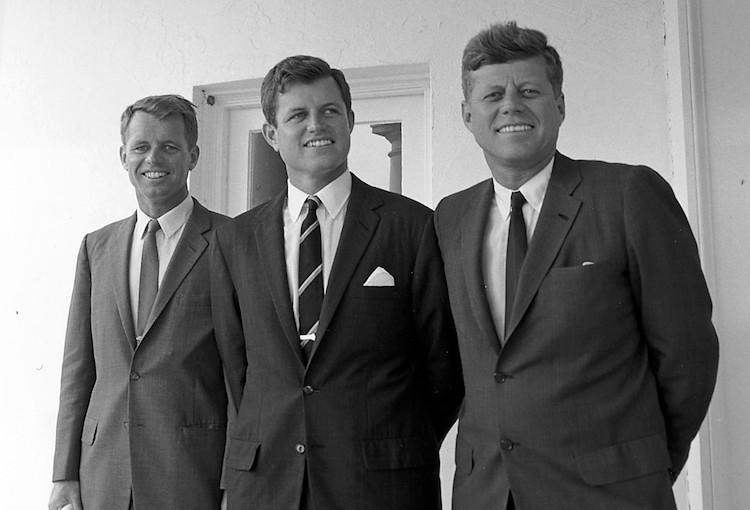 Robert, Ted, and John Kennedy, 1962
Robert, Ted, and John Kennedy, 1962
Robert F. Kennedy, Ted Kennedy, and President John F. Kennedy are pictured together at the White House in 1962, highlighting the three brothers’ prominent roles in American politics.
1969: The Chappaquiddick Incident
In July 1969, Senator Ted Kennedy was involved in a scandal that further fueled the “Kennedy curse” narrative and severely damaged his presidential aspirations. Late one night, after a party on Chappaquiddick Island, Massachusetts, Ted Kennedy drove off a bridge into Poucha Pond with Mary Jo Kopechne, a former campaign staffer, as his passenger.
Kennedy escaped the submerged car, but Mary Jo Kopechne did not. Instead of immediately reporting the accident, Kennedy waited until the following morning, approximately 10 hours later, to contact the authorities. By then, Kopechne’s body had been recovered.
Ted Kennedy pleaded guilty to leaving the scene of an accident causing personal injury and received a suspended two-month jail sentence and a temporary suspension of his driver’s license. The “Chappaquiddick incident” became a major political liability. When Ted Kennedy finally sought the presidency in 1980, he was defeated in the Democratic primaries by incumbent President Jimmy Carter, in part due to the lingering negative public perception from Chappaquiddick.
1973: Ted Kennedy Jr.’s Cancer Diagnosis and Amputation
Ted Kennedy Jr., son of Senator Ted Kennedy and nephew of JFK and RFK, faced a personal health crisis at a young age. In November 1973, at the age of 12, he was diagnosed with osteosarcoma, a form of bone cancer, in his right leg.
To combat the aggressive cancer, Ted Kennedy Jr. underwent amputation of his right leg. Fortunately, the amputation was successful in removing the cancer, and he made a full recovery, becoming an advocate for people with disabilities later in life.
1984: David Kennedy’s Drug Overdose
David Kennedy, the fourth son of Robert F. Kennedy, had a traumatic childhood marked by tragedy. As a child, he nearly drowned but was rescued by his father. The day after this near-death experience, he witnessed his father’s assassination on television, a profoundly disturbing event.
To cope with the emotional trauma, David turned to drugs. A car accident in 1973 led to an addiction to opioid painkillers. Despite numerous attempts at rehabilitation, David struggled with substance abuse for years. In April 1984, at the age of 28, David Kennedy was found dead in a Florida hotel room, the victim of a cocaine and prescription medication overdose.
 Seymour Hersh
Seymour Hersh
Journalist Seymour Hersh, pictured in a promotional image. David Kennedy’s life and struggles tragically reflect the darker aspects often associated with the Kennedy family’s story.
1999: John F. Kennedy Jr.’s Plane Crash
John F. Kennedy Jr., son of President John F. Kennedy, was born shortly after his father’s election and tragically lost him just before his third birthday. In 1999, John Jr., a successful lawyer and magazine publisher, was flying his private plane from New Jersey to Martha’s Vineyard, Massachusetts, en route to a family wedding. He was carrying his wife, Carolyn Bessette-Kennedy, and sister-in-law, Lauren Bessette.
The plane was reported missing after failing to arrive and losing radio contact. Extensive search efforts located wreckage and debris in the Atlantic Ocean. The bodies of John, Carolyn, and Lauren were recovered from the seabed several days later. Investigators concluded that John F. Kennedy Jr. likely became disoriented while descending over water at night, leading to the fatal crash.
The death of JFK Jr., often seen as the “crown prince” of the Kennedy family, resonated deeply with the public and seemed to tragically underscore the enduring narrative of the Kennedy curse for a new generation.

